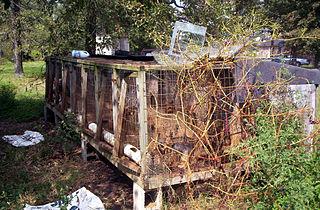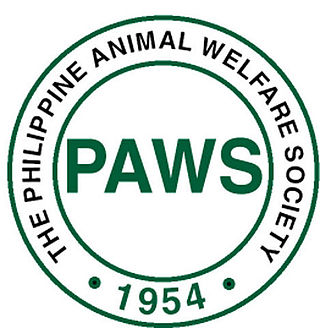The American Society for the Prevention of Cruelty to Animals (ASPCA) is a non-profit organization dedicated to preventing animal cruelty. Based in New York City since its inception in 1866, the organization's mission is "to provide effective means for the prevention of cruelty to animals throughout the United States."

Pet adoption is the process of transferring responsibility for a pet that was previously owned by another party. Common sources for adoptable pets are animal shelters, rescue groups, or other pet owners. Some organizations give adopters ownership of the pet, while others use a guardianship model wherein the organization retains some control over the animal's future use or care.

An animal shelter or pound is a place where stray, lost, abandoned or surrendered animals – mostly dogs and cats – are housed. The word "pound" has its origins in the animal pounds of agricultural communities, where stray livestock would be penned or impounded until they were claimed by their owners.

A puppy mill, also known as a puppy farm, is a commercial dog breeding facility characterized by quick breeding and poor conditions. Although no standardized legal definition for "puppy mill" exists, a definition was established in Avenson v. Zegart in 1984 as "a dog breeding operation in which the health of the mill’s dogs is disregarded to maintain a low overhead and maximize profits". They are cited as being a result of increased demand for household pets, especially after WWII. The Veterinary Medical Association of the Humane Society of the United States defines the main characteristics of a puppy mill as "emphasis on quantity over quality, indiscriminate breeding, continuous confinement, lack of human contact and environmental enrichment, poor husbandry, and minimal to no veterinary care."
Trap–neuter–return (TNR), also known as trap–neuter–release, is a controversial method that attempts to manage populations of feral cats. The process involves live-trapping the cats, having them neutered, ear-tipped for identification, and, if possible, vaccinated, then releasing them back into the outdoors. If the location is deemed unsafe or otherwise inappropriate, the cats may be relocated to other appropriate areas. Ideally, friendly adults and kittens young enough to be easily socialized are retained and placed for adoption. Feral cats cannot be socialized, shun most human interaction and do not fare well in confinement, so they are not retained. Cats suffering from severe medical problems such as terminal, contagious, or untreatable illnesses or injuries are often euthanized.
The Anti-Cruelty Society is an animal welfare organization and animal shelter in the River North neighborhood of Chicago, Illinois. The Anti-Cruelty Society is a private, not-for-profit humane society that does not receive government assistance. It is one of the largest such organizations in the United States. The organization offers adoption, veterinarian, and training services.
An animal rescue group or animal rescue organization is a group dedicated to pet adoption. These groups take unwanted, abandoned, abused, or stray pets and attempt to find suitable homes for them. Many rescue groups are created by and run by volunteers, who take animals into their homes and care for them — including training, playing, handling medical issues, and solving behaviour problems — until a suitable permanent home can be found.
A backyard breeder is an amateur animal breeder whose breeding is considered substandard, with little or misguided effort towards ethical, selective breeding. Unlike puppy mills and other animal mill operations, backyard breeders breed on a small scale, usually at home with their own pets, and may be motivated by things such as monetary profit, curiosity, to gain new pets and/or working animals, or to show children "the miracle of birth".
A no-kill shelter is an animal shelter that does not kill healthy or treatable animals based on time limits or capacity, reserving euthanasia for terminally ill animals, animals suffering poor quality of life, or those considered dangerous to public safety. A no-kill shelter uses many strategies to promote shelter animals; to expanding its resources using volunteers, housing and medical protocols; and to work actively to lower the number of homeless animals entering the shelter system. Up to ten percent of animals could be killed in a no-kill shelter and still be considered a no-kill shelter.
AB 1634 was a 2007 bill in the California State Legislature which would require that dogs and cats in California be spayed or neutered by 6 months of age.

The Philippine Animal Welfare Society (PAWS) is a volunteer-based, non-government organization whose goal is to prevent animal cruelty through education, animal sheltering and advocacy, based in Quezon City, Philippines. It was founded in 1954 by Muriel Jay. PAWS believes that the creation of a more peaceful society starts with the widening of mankind's circle of compassion which includes animals, thereby envisions a nation that respects animals, practices responsible pet ownership and protects wildlife. The volunteer-based organization rehabilitates these animals in the hope of finding them new homes and a second chance at a good life. PAWS does not take in pets of other people, but only victims of cruelty or neglect where the animal offenders are charged with violation of the Animal Welfare Act in court.
The National Animal Interest Alliance (NAIA) is a non-profit organization in the United States dedicated to promoting animal welfare and animal husbandry practices, strengthening the human-animal bond, and safeguarding the rights of responsible animal owners and professionals through research, public education and public policy. The NAIA mission is "to promote the welfare of animals."

Compassion and Responsibility for Animals (CARA) is a registered non-profit, non-government animal welfare organization in the Philippines. It was founded in 2000 by a group of animal lovers determined to help the plight of animals in the Philippines. The current president of CARA is Nancy Cu-Unjieng.

Street dogs, known in scientific literature as free-ranging urban dogs, are unconfined dogs that live in cities. They live virtually everywhere cities exist and the local human population allows, especially in the developing world. Street dogs may be stray dogs, pets which have strayed from or are abandoned by their owners, or may be feral animals that have never been owned. Street dogs may be stray purebreds, true mixed-breed dogs, or unbred landraces such as the Indian pariah dog. Street dog overpopulation can cause problems for the societies in which they live, so campaigns to spay and neuter them are sometimes implemented. They tend to differ from rural free-ranging dogs in their skill sets, socialization, and ecological effects.
Abandoned pets are companion animals that are either inadvertently or deliberately abandoned by their owners, by either dumping the animals on the streets, leaving them alone in a vacant property, or relinquishing them at an animal shelter.
World Spay Day advocates spaying, or neutering, advocating it "as a proven means of saving the lives of companion animals, community cats, and street dogs who might otherwise be put down in a shelter or killed on the street." It is an event held on the last Tuesday in February each year.

The Animal Rescue Foundation (ARF) is a nonprofit organization founded by Elaine and Tony La Russa, based in Walnut Creek, California. ARF rescues dogs and cats from public shelters where they would otherwise be euthanized and adopts them into new homes. Their programs include a spay and neuter clinic, training classes, psychiatric service dog training for military veterans, a volunteer therapy dog program, and humane education programs for children.
The North Carolina Animal Protection Act aims to protect pets and their owners in North Carolina. This legislation models the Animal Welfare Act of 1966 and can be found in the North Carolina General Statutes under Chapter 19A: Protection Of Animals, Article 3, consisting of six articles.
The Richmond SPCA is an idependent non-profit animal shelter in Richmond, Virginia founded in 1891.
The Sato Project is an animal rescue and protection organization founded in 2011 by British-born Christina Beckles. It works to rescue abused and abandoned dogs in Puerto Rico, educating the public and advocating for abused and abandoned dogs. "Sato" is the Spanish word used in Puerto Rico and Cuba for referring to stray dogs or cats. Many of the project's missions have involved airlifting dogs before and after natural disasters, including Hurricane Maria in 2017 and the earthquakes that struck Puerto Rico in 2019 and 2020. "Spayathon" is a spaying and neutering program, attended by Sato Project and other animal rights organizations in Puerto Rico, which has had an impact on the stray dog population.






